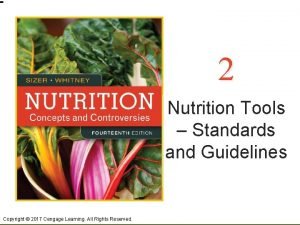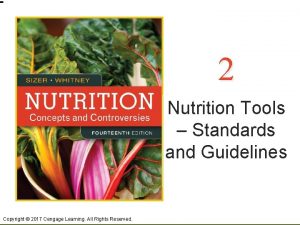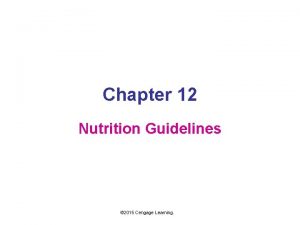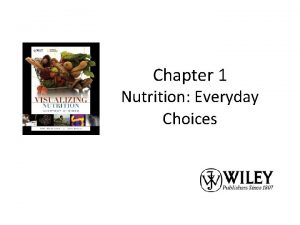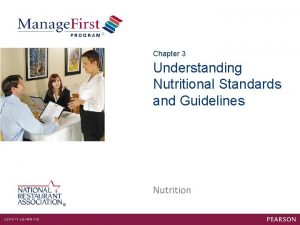Chapter 2 Nutrition Tools Standards and Guidelines Valerie
















- Slides: 16

Chapter 2 – Nutrition Tools: Standards and Guidelines Valerie Schulz, MMSc, RD, LD/N, CDE

Quick review of concepts �Dietary reference intakes (DRIs) are nutrient intake standards set for people living in the United States �The values are based on available scientific research and updated periodically in light of new knowledge �The values are recommendations for optimal intakes, not minimum requirements. Include a generous margin of safety.

DRIs – Dietary Reference Intakes �EAR�RDA�AI�UL�DV- Where find? What kcal level is the standard?

Goals of the DRI Committee

Chap 2 – Diet Planning Applications �A major recommendation of the Dietary Guidelines for Americans is to choose a diet based on a food group plan like the USDA Food Guide. (pg 38 -39, next) �www. Choose. My. Plate. gov �What added benefit do the exchange lists “bring to the table? ” �Exchange lists - appendix D

Chap 2 – Exchange Lists �Exchange lists facilitate calorie control by providing an understanding of how much carbohydrate, fat, and protein are in each food group.

How Much Food Do I Need Each Day?

Chap 2 – Nutrient Density �Definition: The most _________ for the least __________. �Examples of high nutrient density foods: �Examples of low nutrient density foods:

Portion Control �People wishing to avoid over consuming calories must pay attention to portion sizes

Portion Control A serving of grain is 1 oz. , yet most bagels today weight 4 oz. or more-meaning that a single bagel can easily supply more than half of the grains that many people need in a day.

Chap 2 - Phytochemicals �Foods deliver 1000’s of phytochemicals in addition to nutrients. �Bioactive food components, food constituents with the ability to alter body processes. �All provided by phytochemicals: �Burn in hot peppers �Pungency of onions and garlic �Bitter tang of unsweetened chocolate �Aromatic quality of herbs �Beautiful colors of tomatoes, pink grapefruit, and watermelon (to name only a few)

Chap 2 - Phytochemicals �Tips for consuming more phytochemicals: �Eat more fruit �Increase vegetable portions; grated or finely chopped vegetables can be added into lots of places: soups, stews, meatloaf �Add herbs and spices (turmeric, cloves, basil, oregano) �Replace some of the meat in the diet with: � Grains � Beans � Vegetables

Chap 2 – Benefits of antioxidants �Oxidizing compounds damage DNA in animal cells and trigger cancerous changes – antioxidants quench these oxidizing compounds. �Antioxidants reduce oxidative stress and tissue inflammation, both of which are associated with many chronic diseases.

Chap 2 – Antioxidant content of common foods � 1. Blackberries � 2. Walnuts � 3. Strawberries � 4. Spinach � 5. Artichokes, cooked � 6. Cranberries � 7. Coffee � 8. Raspberries � 9. Pecans � 10. Blueberries � 11. Cloves, ground � 12. Grape, cranberry or pomegranate juice � 13. Chocolate, dark, unsweet � 14. Cherries, sour � 15. Wine, red

Chap 2 – Functional foods �Manufactured functional foods consist of processed foods that are fortified with nutrients or enhanced with phytochemicals or herbs. Two examples: �Calcium-fortified orange juice �Margarine blended with a phytosterol that lowers blood cholesterol

Chap 2 – controversy 2 Superfoods �Previous 5 slides have hit some highlights; �Please read all, pages 61 -67
 Nutrition tools standards and guidelines
Nutrition tools standards and guidelines Nutrition tools standards and guidelines
Nutrition tools standards and guidelines Chapter 5 nutrition guidelines tools for healthful eating
Chapter 5 nutrition guidelines tools for healthful eating European quality assurance standards
European quality assurance standards Customer service standards table
Customer service standards table Afnameprotocol machine
Afnameprotocol machine Valérie altuzarra
Valérie altuzarra Valerie nyberg
Valerie nyberg Swift og franzen
Swift og franzen Valérie khodara
Valérie khodara Valerie lavat
Valerie lavat Valerie brossier
Valerie brossier Valerie buitron
Valerie buitron Valerie du preez
Valerie du preez Valerie du preez
Valerie du preez Valerie blair
Valerie blair Valérie langevin
Valérie langevin




















